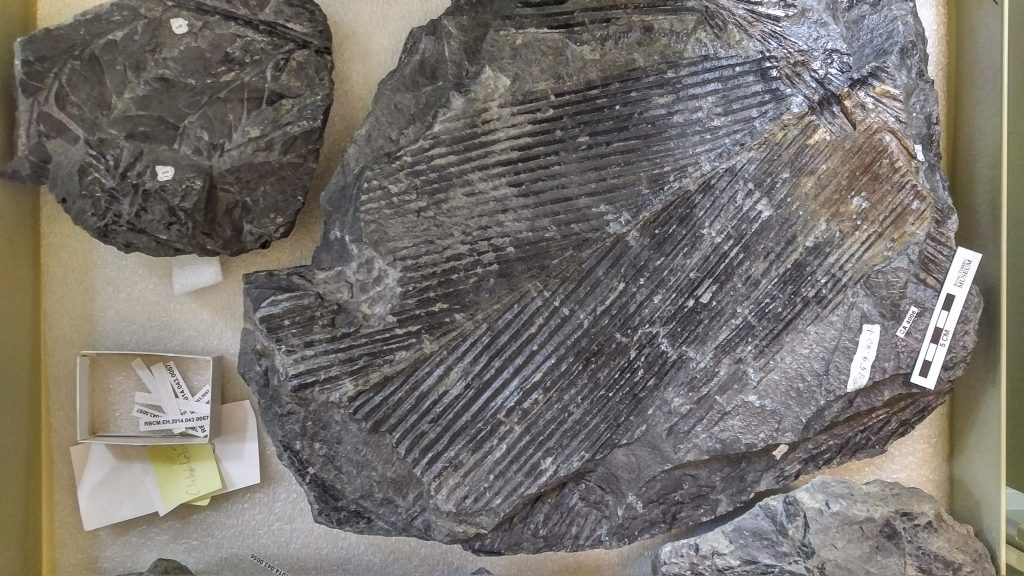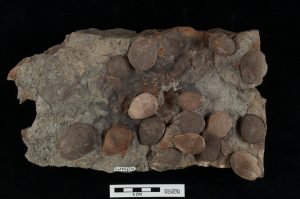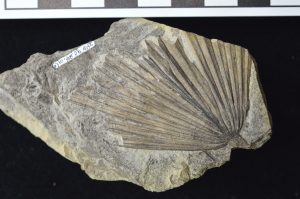Canadian fossil palms

Phoenicites imperialis (Dawson) Greenw. et Conran (syn. Geonomites imperialis (Dawson) Bell) from the Late Cretaceous Cranberry Arms fossil site, British Columbia. RBCM collection. Image © D.R. Greenwood.
Palms (Fam. Arecaceae) are iconic of tropical environments, but formerly were widespread across North America during past times of globally warm climates (Wing & Greenwood 1993; Greenwood & Wing 1995). Fossil palms from Canadian sites have been known since Sir. J.W. Dawson (1883) when he described a feather palm (Geonomites imperialis (Dawson) Bell) from Upper Cretaceous rocks on Vancouver Island (see also Johnson & Hebda 2015), and a fan palm (Sabalites campbelli) from Eocene rocks from Burrard Inlet in Vancouver, British Columbia (Newberry, 1863; Dawson 1895). The Sabalites from the Eocene of Vancouver has now been described as a new species, S. dawsonii (Greenwood & Conran 2020).
The feather palm from Vancouver Is. is occasionally listed as a species of Phoenicites – and this would be correct based on current usage of Phoenicites – however, Dawson’s fossil was transferred to Geonomites by Bell (1956), and this Cretaceous palm species had not been validly taxonomically transferred to Phoenicites. In our now published paper we formally establish the combination Phoenicites imperialis.
Much later, Diane Erwin and Ruth Stockey (1994) described the 3-dimensionally preserved small coryphoid swamp palm, Uhlia allenbyensis from the early Eocene Princeton Chert, BC.
There have been anecdotal references to these early records, but also mention made of Cretaceous and Paleocene palms from Alberta and Saskatchewan, including palm fruits (Ficus ceratops / Spinifructis antiquus) and leaf fossils (e.g., McIver 2002; Aulenback 2009; Bamforth et al. 2014). Many of these Canadian fossil palms remain undescribed, and reviews of the palm fossil record solely list the Dawson (1883) Cretaceous record, and Uhlia allenbyensis.

Fossil palm fruits (TMP1999.052.0001) identified as ‘Ficus ceratops‘, from the Maastrichtian part of the Horseshoe Canyon Formation, AB. Image © RTMP from a specimen on display at the RAM. McIver (2002) transferred similar fossils to Spinifructis antiquus (Dawson) McIver and suggested they are likely cocosoid palm fruits.
Working with Christopher West and Australian colleague John Conran (e.g., Greenwood & Conran 2000 & 2020; Conran & Rozefelds 2003), I am describing the Cretaceous to Eocene fossil palms from BC, Alberta and Saskatchewan (e.g., Greenwood & West 2017; Greenwood & Conran 2020). Recent work on the Paleocene Kanaka Creek flora near Vancouver has revealed additional palm leaf fossils (Mathewes et al. 2020 & in prep.).
The research on the Alberta and Saskatchewan palm fossils (Campanian to Paleocene) is supported by colleagues at the Royal Tyrrell Museum of Palaeontology, the Royal Alberta Museum, the Royal Saskatchewan Museum, and the University of Alberta Paleontology Museum. Work on the BC palms is been aided by colleagues at the Geological Survey of Canada in Ottawa, and the Royal BC Museum in Victoria, BC. Ian Miller at the Denver Museum of Nature & Science in Colorado is assisting with Campanian-aged fossil palms from MT, ND, SD, CO, UT and WY that maybe conspecific with the Campanian to Maastrichtian palms from AB and SK.
In addition, working with Tammo Reichgelt (University of Connecticut) we have precisely determining the climatic limits for the natural distribution of palms globally, to refine the so-called ‘palm line’ (Wing & Greenwood 1993; Greenwood & Wing 1995; Reichgelt et al. 2018) used to constrain Paleogene climate estimates of temperature.
This research is funded by a NSERC Discovery Grant.

Small fan palm fossil (Sabalites sp.) from the Lower Paleocene upper member of the Scollard Formation, Alberta. Collected by Dennis Braman and Kevin Aulenback. Royal Tyrrell Museum of Palaeontology palaeobotany collection (spec. TMP 95 80 01).
References
Aulenback K. 2009. Identification Guide to the Fossil Plants of the Horseshoe Canyon Formation of Drumheller, Alberta. University of Calgary Press, Calgary. (396 pp.)
Bamforth EL, Button CL, Larsson HC. 2014. Paleoclimate estimates and fire ecology immediately prior to the end-Cretaceous mass extinction in the Frenchman Formation (66 Ma), Saskatchewan, Canada. Palaeogeography, Palaeoclimatology, Palaeoecology 401: 96–110.
Bell WA. 1956. Lower Cretaceous floras of western Canada. Mem. Geol. Surv. Canada 285: 1–331.
Conran JG, Rozefelds AC. 2003. Palmoxylon queenslandicum: a permineralised Oligocene palm trunk from near Springsure, southeastern Queensland. Alcheringa: An Australasian Journal of Palaeontology, 27 (2): 125–134, doi: 10.1080/03115510308619553
Dawson JW. 1883. On the Cretaceous and Tertiary floras of British Columbia and the North West Territory. Proceedings and Transactions of the Royal Society of Canada, Ser. 1, Vol. 1, Section IV: 15–34, with 8 plates.
Dawson JW. 1895. On collections of Tertiary plants from the vicinity of the City of Vancouver, B.C. Roy. Soc. Canada, Trans., ser. 2, vol. 1, sect. 4, pp. 137–161, 2 pls.
Erwin DM, Stockey RA. 1994. Permineralized monocotyledons from the middle Eocene Princeton chert (Allenby Formation) of British Columbia: Arecaceae. Palaeontographica Abteilung B 234: 19–40.
Greenwood DR, Conran JG. 2000. The Australian Cretaceous and Tertiary monocot fossil record. In Monocots — Systematics and Evolution, Edited by: Wilson, K.L. and Morrison, D.A. 52–59. Melbourne: CSIRO.
Greenwood DR, Conran JG. 2020. Fossil coryphoid palms from the Eocene of Vancouver, British Columbia. International Journal of Plant Sciences 181(2): 224–240, doi: 10.1086/706450
Greenwood DR, Wing SL. 1995. Eocene continental climates and latitudinal temperature gradients. Geology, 23(11): 1044–1048.
Greenwood DR, West CK. 2017. A fossil coryphoid palm from the Paleocene of western Canada. Review of Palaeobotany and Palynology, doi: 10.1016/j.revpalbo.2016.12.002
Greenwood DR, Conran JG, West CK. 2022. Palm fronds from western Canada are the northernmost palms from the Late Cretaceous of North America and may include the oldest Arecaceae. Review of Palaeobotany and Palynology, 104641, doi: 10.1016/j.revpalbo.2022.104641 Open access.
Johnson CHW, Hebda RJ. 2015. Macroflora, paleogeography, and paleoecology of the Upper Cretaceous (Turonian?–Santonian) Saanich Member of the Comox Formation, Saanich Peninsula, British Columbia, Canada. Canadian Journal of Earth Sciences, 52: 519–536, doi: 10.1139/cjes-2014-0180
Mathewes RW, Greenwood DR, Love, RL. 2020. The Kanaka Creek fossil flora (Huntingdon Formation), British Columbia, Canada—paleoenvironment and evidence for Paleocene age using palynology and macroflora. Can. J. Earth Sci. 57(3): 348–365, doi: 10.1139/cjes-2018-0325
Reichgelt T, West CK, Greenwood DR. 2018. The relation between global palm distribution and climate. Scientific Reports, 8(1): 4721, doi:10.1038/s41598-018-23147-2, Open Access [URL]
McIver EE. 2002. The paleoenvironment of Tyrannosaurus rex from southwestern Saskatchewan, Canada. Canadian Journal of Earth Sciences, 39(2): 207–221, doi: 10.1139/e01-073
Newberry JS. 1863. Species of plants collected by Dr. John Evans at Nanaimo (Vancouver Island) and at Bellingham Bay, Washington territory. Boston J. Nat. Hist., 7: 506–524.
Wing SL, Greenwood DR. 1993. Fossils and fossil climates: the case for equable Eocene continental interiors. Philosophical Transactions of the Royal Society, London B, 341: 243–252.
